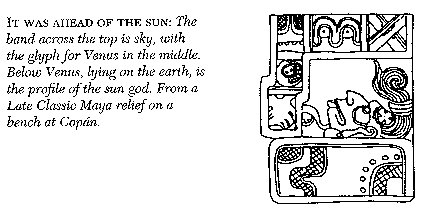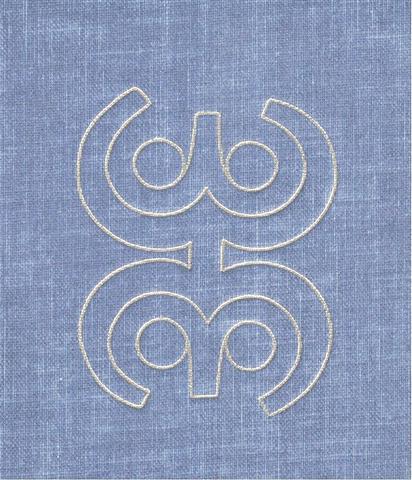The Mayas illustrated Venus as a pair of 'eyes' separated by periods when the planet was absent from the sky:
Their design was used thrice at Gemini (representing the place of regeneration, life, multiplication) and once at Saturn (representing the place of death):
In the Mars cartouche there is a table plate for the Middleworld (Earth),
supported by the left hand of Mars above a pair of quincunx stars. In front the Sun 'eye' is pushed up high by the right arm of Mars. The upper shell of the Turtle at Orion - beyond Saturn and evening star Venus - supports 3 more quincunx designs. ... Al Maisān, the title of γ Geminorum, by some error of Firuzabadi was applied to this star as Meissa, and is now common for it. Al Sufi called it Al Tahāyī; but Al Ferghani and Al Tizini knew it as Rās al Jauzah, the Head of the Jauzah, which it marks. The original Arabic name, Al Hak'ah, a White Spot, was from the added faint light of the smaller φšand φ˛ in the background, and has descended to us as Heka and Hika. These three stars were another of the Athāfiyy [tripods used for cooking] of the Arabs; and everywhere in early astrology were thought, like all similar groups, to be of unfortunate influence in human affairs. They constituted the Euphratean lunar station Mas-tab-ba-tur-tur, the Little Twins, a title also found for γ and η Geminorum; and individually were important stars among the Babylonians, rising to them with the sun at the summer solstice, and, with α and γ, were known as Kakkab Sar, the Constellation of the King ... On Easter Island there was a God or Lord named Makemake (Te Atua ko Makemake) and his face resembled the Mayan version of the face of Venus, showing only the front of the top of his head: ... The following picture of a sculptured stone (copied from Van Tilburg) was said to represent the multiple faces of Makemake:
In another and more refined version the resemblance is quite obvious:
... The hard cover (vol. 2) of the report from the Norvegian archaelogical expedition to Easter Island ... bears a striking design ... The picture is transferred from a stone ball found '... between the lava boulders covering the ahu at Hanga-tetenga ... The sculpture is almost spheroid, with a slight flattening of the ventral side, the rest of the surface being covered by a double-headed animal carved in low relief in such a manner that the heads face in opposite directions on each side of a round mutual body ... Could the creator of the G text have used his pair of manu kake glyphs to illustrate Venus at the horizon in the west respectively Venus at the horizon in the east?
The glyph for nakshatra JANUARY 1 could perhaps show how south of the equator the number of Sun light days ahead were 3 * 91 = 273 when at the same time north of the equator they would have been only around 1 * 91 = 364 - 273. Another possibility is that there was an allusion to the Front of the Head of Ku, which came 3 days before the Back of the Head of Ku:
The Mayas did not use the true number of nights for the phases of Venus, instead they manipulated the morning star period to be 236 days instead of 263. Probably this was at least partly due to the fact that 8 * 29˝ = 236, which made the morning star period be in harmony with the lunar phases:
The G text can be measured out as 8 lunar synodic double-months (if we count also day zero which is not represented by any glyph), i.e. as 2 * 236 = 472 days. 236 + 90 (cfr the Mayan length for the period between morning and evening star Venus) = 326 and 326 / 2 = 163, which number happens to agree with the ancient heliacal date number for the Head of the Lion - given that we also count day zero although not represented by any glyph. 584 - 236 = 348 (= 12 * 29) and this was used for the number of glyphs on side b of the C table. The number of glyphs on side a of the C tablet was 392 (= 584 - 192). Or 393 = 594 - 193 if we should count with a day zero at the beginning of the side. ... Complementary to 24 was 168 = 192 - 24 [= 7 * 24]. And 192 = half 384 = 364 + 20 ... The influence from Venus on this pair of complementary rongorongo texts (C and G) is evident. (584 - 236) + (584 - 192) = 740 (number of glyphs on the C tablet). And 740 (C) + 472 (G) = 1212 = 584 + 2 * 314. In other words, the whole circle (2π) of Venus was 584 nights. Also in the long Tahua text can we find traces of the Venus cycle, for instance:
The right side of this cranium exhibits a point (tara) and the left side has possibly been drawn like the handle of a water jar:
|
|||||||||||||||||||||||||||||||||||||||||||||||||||||||||||||||||||||||||||||||||||||||||||||||||||||||||||||||||||||||||||||||||||||||||||||||||||||||||||||||||||||||||||||||










